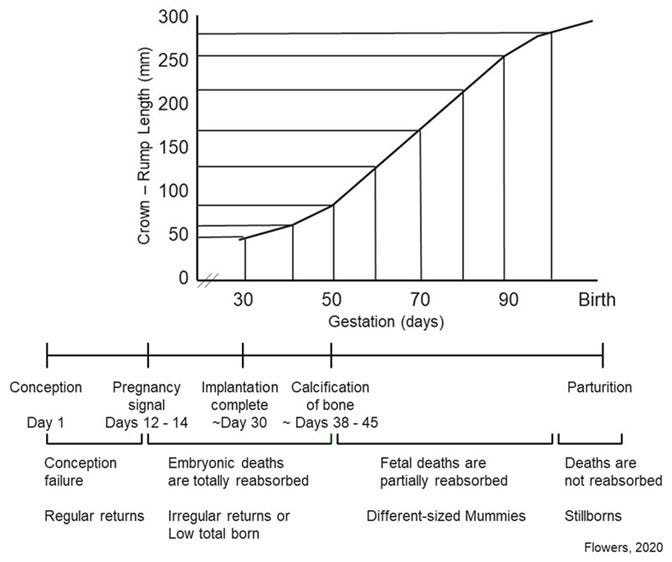Understanding the physiology associated with reproductive losses
If there are considerably more sows with irregular returns, then this typically is caused by management conditions two to four weeks after breeding.
July 6, 2023

When sows are bred the expectation is that they will farrow a large litter of pigs about 114 days later. If this doesn't happen, then an obvious question is what went wrong? Identifying causes of reproductive failures can be a challenging task because there often is an extended period of time between when the loss occurred physiologically and when it is first observed on the farm. However, a careful evaluation of type of reproductive failure observed in conjunction with the sow's normal reproductive physiology can simplify the process in most situations.
The figure contains a summary of key reproductive events associated with successful pregnancies in swine and the most common clinical signs observed when they don't occur. The general consensus is that there need to be at least four to five healthy embryos present in the uterus after breeding in order for a sow to maintain her pregnancy to term. If this criterion is not met by day 12 post breeding, then the sow never really knows that she is pregnant and will return to estrus 18 to 22 days after being bred.
These are the females that are referred to as having "normal returns to estrus." If enough healthy embryos are present at day 12, but, for whatever reason, some die between days 12 and 28 of pregnancy, then these females will eventually show estrus but at intervals greater than 18 to 22 days and are classified as having "irregular returns to estrus."

The relative proportion of sows with regular and irregular returns to estrus can be used as a starting point for where to begin to look for problems. If there are considerably more sows with regular returns then this usually indicates a problem with heat detection; semen quality; insemination technique or management conditions during the first two weeks after breeding. In essence, these sows never conceived.
If there are considerably more sows with irregular returns, then this typically is caused by management conditions two to four weeks after breeding. In this situation sows conceived; however, they were not able to support the development at least four viable embryos after day 12.
Finally, if there are equal numbers of sows with regular and irregular returns, then this most likely is due to a situation related to the incomplete recovery of the sow's reproductive system prior to her being rebred and is usually related to management conditions during lactation. What happens in these situations is that the sow has a low ovulation rate and/or her uterus isn't completely recovered when she was rebred and depending on when the embryo losses occur determines whether she has a regular or irregular estrus. Poor feed intake and inconsistent nursing patterns by piglets probably are two of the most common contributing factors for this situation.
Reproductive losses that occur later in pregnancy usually result in small litter sizes or an increase in mummified fetuses and stillborn piglets. Around day 45 of pregnancy is when calcification of bones in the developing fetuses occurs. If fetuses die prior to this, then the sow reabsorbs them completely. Decomposition and reabsorption of dead fetuses is a normal process in litter bearing females.
If the fetuses die between days 45 and around day 90, then the sow reabsorbs the soft tissue but not the bones and these end up being delivered as mummified fetuses. The size (chart in the figure) and degree of decomposition is inversely related to when the fetus died: small mummies that are highly decomposed died closer to days 45 to 50 while later ones with less decomposition died closer to day 90. Stillborn piglets are fully formed, normal looking fetuses that are born dead. These died late in gestation or during parturition so there wasn't sufficient time for any significant decomposition.
With the summer months approaching, it is important to remember that heat stress has the potential to affect all the sows on a farm over the same time frame. This is referred to as a "whole-herd stressor." As a result, all of the types of reproductive failures mentioned previously could be observed: stillborn piglets for sows in late gestation; mummified fetuses for sows in mid-gestation; and some combination of regular and irregular returns for sows in lactation and early gestation depending on when the elevated temperatures begin and how long they persist.
You May Also Like



